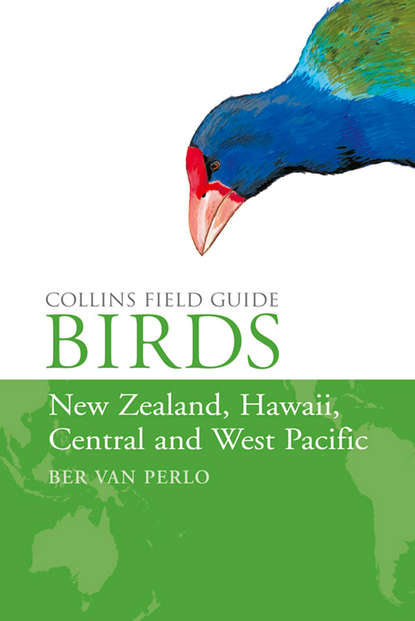По всем вопросам обращайтесь на: info@litportal.ru
(©) 2003-2024.
✖
Birds of New Zealand, Hawaii, Central and West Pacific
Настройки чтения
Размер шрифта
Высота строк
Поля
• the scientific name in italics;
• length in cm, measured from tip of bill to tip of tail (L) or between the tips of spread wings (W);
• identification notes with emphasis on the main features, or those that are not visible in the plates (e.g. the colour pattern that appears when a bird opens its wings) or those that are most important for separation from similar species. Notes on behaviour are often added when important for identification;
• habitat (the set of environmental factors, preferred by a bird species) preceded by the symbol
; only simple terms are used such as forest, woodland, marsh, plantations, savanna;
• voice, preceded by the symbol
where possible a distinction has been made between ‘call’ and ‘song’ as being the basic vocalisations of birds, ‘call’ being any short, probably unrestrainable sound, given by a bird to indicate its presence to himself or other animals, ‘song’ being the modus in which a
(sometimes also the
) advertises its possession of a territory or its mood (anger, nervousness, contentment, togetherness).
In the voice, attention is paid to:
• pitch, using a subjective scale ‘very low, low, mid-high, high, very high, very/extremely high, extremely high’, wherein ‘very low’ and ‘extremely high’ indicate vocalisations that are just not quite too high or too low to be audible and ‘mid-high’ for the normal pitch of an average person’s voice, if trying to imitate the vocalisation;
• speed, for which terms are used as ‘very slow, slow, calm, rapid, hurried, fast’;
• tempo, as defined by the ‘length’ between notes, indicated by the use or absence of hyphens between notes, so beep beep beep is slower than beep-beep-beep, while beepbeepbeep is the fastest. Also terms such as rattle and trill are used to describe tempo; an apostrophe as in t’sreee is used to indicate a short, yet noticeable separation between two consonants;
• loudness, described as soft, weak, loud, ringing, etc.;
• structure, indicated by terms such as accelerated, lowered, gliding, crescendo, staccato, etc.;
• length of song or call given in seconds;
• quality in terms such as harsh, shrieking, mewing, etc.;
• transcriptions – this is the most difficult way to describe ‘voice’ for several reasons: different people will transcribe bird vocalisations using different vowels and consonants (for example, compare the way in which in several bird guides the chirping of a house sparrow is transcribed) and the differences that exist between written and spoken text in different languages (French people will transcribe a sound in a different way to a Dutch or English speaker).
To keep transcriptions short, use is made of the punctuation mark ‘-’ to indicate repetition of one or more foregoing notes. In ‘preep -’ the note(s) are repeated 1–3 times, in ‘preep - -’ the repetition is more than three times and in ‘preep—’ the repetition is given very fast.
The use of an acute accent on a vowel, for example in weétjer, means that part is accentuated; the diacritic grave, as in rèh-rèh rèh, is used to indicate that the ‘e’ sounds as the ‘e’ in ‘red’; similarly, ò sounds as the ‘o’ in ‘pot’; parts of transcriptions written in capitals are uttered louder.
The vocalisations in this book might support an identification or may make it easier to remember a bird sound when it is heard again. However, it should be kept in mind that though the vocalisations of many seabirds, herons and other large waders are described, they vocalise only or mainly in, above or near their breeding colonies.
The description of voice in this book is based on tapes, CDs and DVDs (see Bibliography).
Distribution Maps
Information about range, seasonality and occurrence can be an important aid in supporting or weakening an identification. In the distribution maps, attention is paid to these factors, expressed in the key on page 14.
The Area Covered
The area encompasses the following 20 political entities, given in random sequence:
• Hawaii (US State)
• Fiji (Republic)
• Tonga (Kingdom)
• Nauru (Republic)
• Samoa (Republic)
• American Samoas (US unincorporated Territory)
• Kiribati (Republic)
• Marshall Islands (Republic)
• Federated States of Micronesia (free association with the USA)
• Tuvalu (British Commonwealth)
• Tokelau (New Zealand Territory)
• Niue (free association with New Zealand)
• Cook Islands (free association with New Zealand)
• Guam (US unincorporated Territory)
• Wallis and Futuna (French Overseas Collectivity)
• Pitcairn Islands (UK Overseas Territory)
• Northern Marianas (Commonwealth in union with USA)
• Palau (Republic)
• French Polynesia (French Overseas Territory)
• New Zealand (British Commonwealth)
The Environment
Some Basics for Oceania
The following paragraphs give a short introduction to the factors that determine the presence and distribution of bird species in the area. The main factor that dominates all others is that the area is composed of islands, varying between very large and very small, lying either far apart from or close to each other. All these islands have been uplifted from the ocean bottom by tectonic activity; those in the tropics are modified by reef building. Almost all islands, except the most southern ones, were once covered by forest. The final stage in the formation of habitats was the way in which people transformed and used the environment.
TECTONICS The outer mantle of the earth is formed by solid rock (the lithosphere), covered by an accumulation of sediments, volcanic products and changed basic rock (the crust). The lithosphere overlays the asthenosphere, a mantle of plastic flowing rock.





